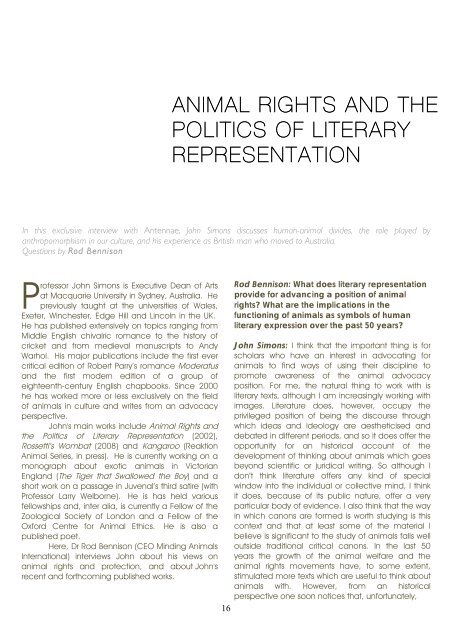Animal Wrongs and Rights - Antennae The Journal of Nature in ...
Animal Wrongs and Rights - Antennae The Journal of Nature in ...
Animal Wrongs and Rights - Antennae The Journal of Nature in ...
Create successful ePaper yourself
Turn your PDF publications into a flip-book with our unique Google optimized e-Paper software.
Pr<strong>of</strong>essor John Simons is Executive Dean <strong>of</strong> Arts<br />
at Macquarie University <strong>in</strong> Sydney, Australia. He<br />
previously taught at the universities <strong>of</strong> Wales,<br />
Exeter, W<strong>in</strong>chester, Edge Hill <strong>and</strong> L<strong>in</strong>coln <strong>in</strong> the UK.<br />
He has published extensively on topics rang<strong>in</strong>g from<br />
Middle English chivalric romance to the history <strong>of</strong><br />
cricket <strong>and</strong> from medieval manuscripts to Andy<br />
Warhol. His major publications <strong>in</strong>clude the first ever<br />
critical edition <strong>of</strong> Robert Parry’s romance Moderatus<br />
<strong>and</strong> the first modern edition <strong>of</strong> a group <strong>of</strong><br />
eighteenth-century English chapbooks. S<strong>in</strong>ce 2000<br />
he has worked more or less exclusively on the field<br />
<strong>of</strong> animals <strong>in</strong> culture <strong>and</strong> writes from an advocacy<br />
perspective.<br />
John's ma<strong>in</strong> works <strong>in</strong>clude <strong>Animal</strong> <strong>Rights</strong> <strong>and</strong><br />
the Politics <strong>of</strong> Literary Representation (2002),<br />
Rossetti’s Wombat (2008) <strong>and</strong> Kangaroo (Reaktion<br />
<strong>Animal</strong> Series, <strong>in</strong> press). He is currently work<strong>in</strong>g on a<br />
monograph about exotic animals <strong>in</strong> Victorian<br />
Engl<strong>and</strong> (<strong>The</strong> Tiger that Swallowed the Boy) <strong>and</strong> a<br />
short work on a passage <strong>in</strong> Juvenal’s third satire (with<br />
Pr<strong>of</strong>essor Larry Welborne). He is has held various<br />
fellowships <strong>and</strong>, <strong>in</strong>ter alia, is currently a Fellow <strong>of</strong> the<br />
Zoological Society <strong>of</strong> London <strong>and</strong> a Fellow <strong>of</strong> the<br />
Oxford Centre for <strong>Animal</strong> Ethics. He is also a<br />
published poet.<br />
Here, Dr Rod Bennison (CEO M<strong>in</strong>d<strong>in</strong>g <strong>Animal</strong>s<br />
International) <strong>in</strong>terviews John about his views on<br />
animal rights <strong>and</strong> protection, <strong>and</strong> about John's<br />
recent <strong>and</strong> forthcom<strong>in</strong>g published works.<br />
ANIMAL RIGHTS AND THE<br />
POLITICS OF LITERARY<br />
REPRESENTATION<br />
In this exclusive <strong>in</strong>terview with <strong>Antennae</strong>, John Simons discusses human-animal divides, the role played by<br />
anthropomorphism <strong>in</strong> our culture, <strong>and</strong> his experience as British man who moved to Australia.<br />
Questions by Rod Bennison<br />
16<br />
Rod Bennison: What does literary representation<br />
provide for advanc<strong>in</strong>g a position <strong>of</strong> animal<br />
rights? What are the implications <strong>in</strong> the<br />
function<strong>in</strong>g <strong>of</strong> animals as symbols <strong>of</strong> human<br />
literary expression over the past 50 years?<br />
John Simons: I th<strong>in</strong>k that the important th<strong>in</strong>g is for<br />
scholars who have an <strong>in</strong>terest <strong>in</strong> advocat<strong>in</strong>g for<br />
animals to f<strong>in</strong>d ways <strong>of</strong> us<strong>in</strong>g their discipl<strong>in</strong>e to<br />
promote awareness <strong>of</strong> the animal advocacy<br />
position. For me, the natural th<strong>in</strong>g to work with is<br />
literary texts, although I am <strong>in</strong>creas<strong>in</strong>gly work<strong>in</strong>g with<br />
images. Literature does, however, occupy the<br />
privileged position <strong>of</strong> be<strong>in</strong>g the discourse through<br />
which ideas <strong>and</strong> ideology are aestheticised <strong>and</strong><br />
debated <strong>in</strong> different periods, <strong>and</strong> so it does <strong>of</strong>fer the<br />
opportunity for an historical account <strong>of</strong> the<br />
development <strong>of</strong> th<strong>in</strong>k<strong>in</strong>g about animals which goes<br />
beyond scientific or juridical writ<strong>in</strong>g. So although I<br />
don’t th<strong>in</strong>k literature <strong>of</strong>fers any k<strong>in</strong>d <strong>of</strong> special<br />
w<strong>in</strong>dow <strong>in</strong>to the <strong>in</strong>dividual or collective m<strong>in</strong>d, I th<strong>in</strong>k<br />
it does, because <strong>of</strong> its public nature, <strong>of</strong>fer a very<br />
particular body <strong>of</strong> evidence. I also th<strong>in</strong>k that the way<br />
<strong>in</strong> which canons are formed is worth study<strong>in</strong>g is this<br />
context <strong>and</strong> that at least some <strong>of</strong> the material I<br />
believe is significant to the study <strong>of</strong> animals falls well<br />
outside traditional critical canons. In the last 50<br />
years the growth <strong>of</strong> the animal welfare <strong>and</strong> the<br />
animal rights movements have, to some extent,<br />
stimulated more texts which are useful to th<strong>in</strong>k about<br />
animals with. However, from an historical<br />
perspective one soon notices that, unfortunately,












